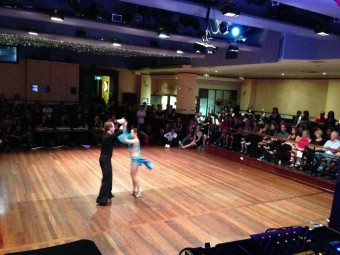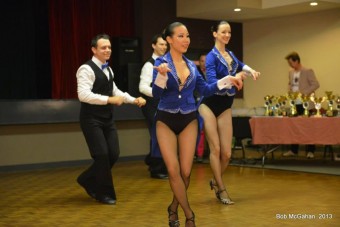
I recently competed in the Australia Salsa Open – an annual Latin dancing competition which grants the champions to represent Australia in the World Salsa Open in Puerto Rico. I didn’t place, but came back with more knowledge and experience…and it reminded me of why and how I became a salsa addict.
From a young age, my mother decided that I should do ballet to make up for her lost opportunity when she was a girl. Seen as an activity with strict discipline, utmost femininity and benefits in individual musicality and technique, ballet was a popular choice of extra-curricular activity among parents for their daughters. On the other hand, Ballroom or Latin, in fact, any form of partner dancing, was never very popular in Hong Kong. The Chinese cultural protocols and social perspectives still lurked around in our society. Physical contact between girls and boys were frowned upon and thus avoided. To dance and to express through body language was seen as a relatively feminine act.
Classical ballet training established a strong technical foundation for me to pursue any kind of dance form or body movement. I also developed an interest in keeping up my flexibility. However, ballet training was tough and demanded a lot of hours. Graduating from high school, other priorities took over. Although I still frequented dance studios for the odd ballet class or hip hop lesson, I knew I was ready for a change and a new challenge.
Moving to Brisbane, I discovered a whole new world in Latin dancing, especially salsa.
Partner dancing was a mystery. I knew that it works because there is a designated leader and follower. The leader, traditionally the man, leads; the follower, usually the lady, follows. It came as no surprise that the first few weeks of learning how to salsa involved a cruel process of giving up control and learning how to be led. I had to stop thinking about what should come next; I couldn’t expect or presume. As a follower, you’re almost always in for a whole lot of surprises.
I didn’t like that at all. But I gradually came to understand the energy flow and connection that could be created between partners, and it was liberating. I started to enjoy being led because all I had to do was to keep the connection and feel the energy. I didn’t have to worry about forgetting steps in between and what should come next. Partners were also constantly rotated. Many people showed up to classes on their own, and changing partners also helped to improve leading and following techniques. It reinforced what works well and what doesn’t. Before I even realised, I was taking four to five classes a week.
When I discovered social dancing, my addiction intensified.
At every social dance party, there’s bound to be a crowd of dancers at various levels of abilities and experience who are ready to delve into the next song with a random partner, or one of their choosing. For me, social dancing is one of the most important aspects of learning, improving and developing as a better dancer. The social dance floor is a ground for experimentation and play with various combinations of movements, resolutions to tangled arms and attempting multiple spins.
On top of social dancing, styling and shines made it even more cool. Ladies can use styling to decorate dance movements. As a form of partner dancing, there are always breaks in salsa music where your partner lets you go. Both the follower and leader can then do shines by using intricate footwork or body movement to play with the music and show off what they can do. I was instantly hooked learning about these possibilities of expressing individuality and I was soon dancing six nights a week.
Although Latin dancing is not traditionally embraced by Asians, the Brisbane Latin dance scene is definitely not shy of Asians. You could easily spot boys and girls from China, Malaysia, Japanese, Korea and India having a good time on the social dance floor any night. Talking to many of them, they’ve pointed out that Latin dancing is a good way to connect and bond with other people. Opportunities to meet people from all walks of life and network outside your professional circles are readily available. Moreover, most Asians are not big drinkers and dancers aren’t either. Living in a country with a well-established drinking culture, Latin dancing is definitely something fun to do without needing any alcohol.
With my background in ballet and after two years of salsa dancing, I wanted to put my abilities to the test by competing in the Australian Salsa Open. I wanted to become a stronger dancer and to have a taste of what it requires to become a better Latin dance performer and competitor.
One of my classmates at the studio, Chris, had expressed an interest in competing earlier in the year. He used to be a ballroom dancer and had been dancing salsa for three years. In consultation with our instructors, we decided to compete as a salsa amateur couple.
There was no doubt my partner and I would qualify in the Queensland State Championships. Competition in Brisbane was scarce, compared to Sydney or Melbourne, but that also meant slower improvement and learning due to the lack of inspiration from and limited sightings of high-quality dancers. Stepping into the venue in Sydney for the national competition for the very first time, the atmosphere was tense and overwhelming. A mass of dancers were on the floor drilling their steps and turns in preparation for the evening.
Among a total of 260 competitors, perhaps only about 5% or less were Asians. None of those competitors in professional categories were Asian either. Having delved into the Latin dance scene in Hong Kong and networked with dancers from Korea and Singapore, I can say that the Latin dance scene in Asia and the concept of Latin dancing among Asians is still developing. The short history of Latin dancing in Asia is probably one of the major reasons for the lack of well-known, world-class dancers who compete at an international level.
In between my training to become a better Latin performer, I was constantly pushed out of my comfort zone. The Latin style of performing did not sit well with me culturally. Latin performances are usually in small spaces surrounded by big crowds. As the performer dancing at a close distance to your audience, you have to be confident, energetic, have a bit of sex appeal and convey excitement through facial expressions. I’m not one with a ‘loud’ personality and adopting such a style of performing proved to be very difficult.

Nonetheless, after three months of training, sweat, sleep-deprivation and physical exhaustion, the competition was done and dusted. Looking back, I started salsa dancing mainly for fun… and it hasn’t been one bit disappointing. I realised competition and choreography is nothing like social dancing. Competition training also re-ignited my passion for social dancing and dancing for fun. And the most valuable lesson I took away from this? Well, it proved that the journey is almost always more important than the destination or result.
My journey’s just starting to become exciting……I can’t wait to see where it leads me.

